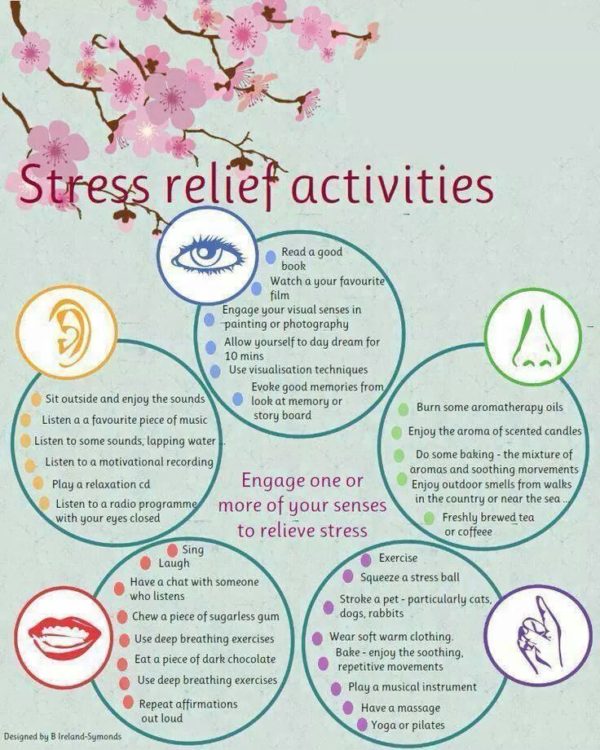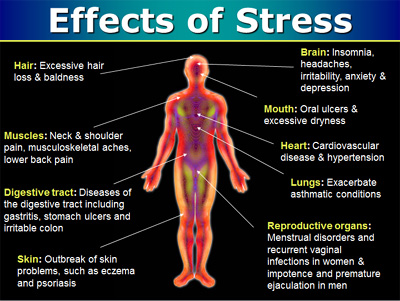Scientists have ascertained that five-minute self-massage helps in bringing down the BP, heart rate and free one of the feeling of panic. Increasing worries and daily annoyances can get sorted out and bring relief just by self-massaging during the day.The way stress plays and damages us can get controlled by self-massage on a regular basis.
It is important to realize that the stress plays and works with or against us. Brief sessions of stress prepare us to get ready and remain alerted to tackle day to day happenings. Long work hours would mean constant stress or tension, that would amount to over build up of pressure resulting in a reduction of mental and physical energy. The slow and cumulative effect, in the end, will be sickness and disease. The systems of the body become slow and finally turn non-responsive with the passage of time. The immune system eventually weakens and slows down to respond.
Counteracting Stress by Systematic approach: By the following methods one can meet head-on and solve the problem and live healthily and make life more meaningful, creative and joyful.
1) Profound and prolonged breathing: Deep breathing would relax and have a calming effect on the mind and body. Continue so for at least 5 to 7 minutes, and the stress will reduce for certain.
2) Number counting starts Meditation: Take a comfortable position, close your eyes as that helps in less disrupting of thoughts and start counting numbers. Free your mind of any thoughts by acknowledging the idea but do not stop number counting; you will find tension leaving very slowly. Remember not to stop counting. Stopping all reflections and concentrating on the numbers will lead to meditation.
3) Imagination: It is the virtual experience of believing to get into a position to be in a place or position where you feel relaxed. By imagination, you can focus to be in a state of mind whereby you reach and feel good in thought as you may have experienced in your life.

Photo source: Pinterest.com
How does stress affect:
Stress has a dual function- it works on short and long Term 1) Short-term stress, that which lasts for a limited period 2) Long-term: Stress for extended periods of time or days or months or years and that is a harbinger of permanent damage to physical health and thinking. Following benefits or losses occur due to either type of stress, short-term and long-term:
- Skin: Short-term: Whenever the blood gets diverted from the skin to other parts it turns lighter, dehydrated and delicate. Long-term Stress: Skin erupts, dermatitis, itching, the uncomfortable sensation that makes one to scratch and dry skin.
- Intestine, and Bladder: Short term: The urge is to empty out the stomach and waste from both intestine and bladder. Long term: The victim has very tough time and remains sick for a long time without sleep and sometimes leading to bleeding through the rectum.
- Fibrous tissues (Muscles): Short-term- They respond by performing readiness for any last task to complete or flee or get away. Long- term: Tissues become sluggish, very slow to respond because of pain or hardening or have a reoccurrence of pain.
- State of Mind or Mood: For short-time, the stress is needed to enhance the attention span. The long-term, One is certain to develop tension and crisis, thereby committing silly errors.
- Nervous Activity Center or Brain: The short-term stress would enhance the blood supply thereby promoting clarity of thought and action, alertness all in one go. Long-term under stress means Nervousness, migraine, low self-confidence, headache, nervousness, inability to speak or express as needed.
- Innard / Liver: Whenever under short-term stress it takes care to release additional quantities of glucose and fats into the blood circulatory system for more energy. The long-term stress: the lastingly elevated level of blood sugar plus the fats would lead to diabetes, heart attack, and other heart-related diseases.
- Lungs: In the short-term stress the lungs get pushed to take in more oxygen by increased breathing to activate tissues and the cerebrum ( brain). Long term stress: Cold or a cough, difficulty in breathing normally, hyperventilation Dizziness, creeping sensation in the lips, hands or feet, migraine, faintness, fainting, and fits. In extreme cases, it can cause seizures (beating and squeezing of the hands and feet)
- Hormones: Short-term stress activates the endocrine glands that secrete various hormones through the circulatory system for immediate action at different locations in the body. The long-term stress slows down the immune system thereby produce the heightened risk of disease.
- Heart: Short term stress increases the blood supply to the parts required especially to the muscles and brain. Long-term-stress weakens the heart and multiplies the risk of diseases like high BP, pulsations
- Saliva: Short-term dries the mouth when not feeding. The long-term stress drains the blood and results in the sensation of a lump in the mouth.
- Genitals: Short-term stress: Blood gets deflected to the other parts of the body. Long-term stress means inaction of the sexual organs in the males, and females cannot get the orgasm and disability of menstrual cycle.
 Picture source: Pinterest.com
Picture source: Pinterest.com
WAYS SELF-MASSAGE INFLUENCE THE SYSTEMS OF THE BODY:
- BLOOD CIRCULATORY SYSTEM: When blood circulatory system works correctly the body’s various organs function properly. But the blood may not perform as required because of many reasons like advanced age, accident or malfunction of a body. Self-massage helps in restoring the blood supply level in a short time. The journey of blood gets traced from the heart through lungs that purify the blood and arm with oxygen, next through liver that supplies nutrients like glucose, fats and the amino acids. The amount of the blood gets carried through the blood vessel called the arteries. The amount reaches the body parts through the smaller tubes called arterioles and through the capillaries.
- MUSCLES, TISSUES, BONES, AND JOINTS:
- Bones form the core structure of a body. The pair of muscles move the joints of bones by the connective tissues or the cords or threads called the tendons. There are about 650 voluntary muscles in a human body, but there are also involuntary muscles. The muscles are on the either sides of the joints and while they stretch on the one hand the other hand contracts. Muscles work is done by the supply of blood and lymphatic vessels. Whenever a muscle works, the oxygen and nutrients get provided for the energy and heat generation. When they contract the used blood and waste, or impurities and by-products of the chemical process get pushed out. Whenever the muscles work, the energy or oxygen supplied vigorously gets consumed faster than the supplied amount then the waste product generated is called lactic acid that sets in tiredness, tiredness, pain, and fatigue. It should get evident that some muscles are under partial stretch tension to maintain a posture or while sitting or lying down.
Muscles stretching for prolonged period get deprived of the oxygen and nutrients, and in due course, the waste products and poison get collected that affect the body adversely in the form of lump, soreness, swelling, aching and develop severe pain.
Advantages of Self-Massage:
Self-massage is a storehouse of relaxing the muscles and joints by reducing the tension, reducing the narrowing with the additional benefit of the movement.
- Whenever the muscles are allowed to rest through self-massage, the tension and compression of the muscles get activated.
- The muscles work more efficiently on the application of self -massage so that the muscles tissues get developed, extended and separated, and any adhesion gets broken down thus they allow muscles to contract and relax and work with better output.
- The self-massage increases the joint movement thus reducing swelling, stiffness, aches, and fatigue due to long hours of stretching or remaining in a particular position. It is because of continuous supply of oxygen and nutrients and removal of wasted products and excess fluids.
- The physical activity gets undertaken as blood supply, and frictional heat generates warmth in the areas massaged.
- The younger, smoother appearance become the order of the day with a facial massage that relaxes the muscles and tissues of the face, thus removing tension lines and tones up the muscles thoroughly.
Benefits of Self Massage to the Lymphatic system:
The lymphatic system gets to take advantage of self-massage in the following ways:
- Quick elimination of the metabolic wastes, toxins, and excess fluid wastes brings the body’s muscles and tissues to work more efficiently.
- An efficient flow of lymph through the intestine ensures the supply of fat to different organs.
- The onslaught of any disease gets countered by the lymphatic system, thus providing the defense of the defense (immune) system to prevent the onset of infections.
- The proteins from the cells get collected and mixed with the blood for disposal to other areas.







